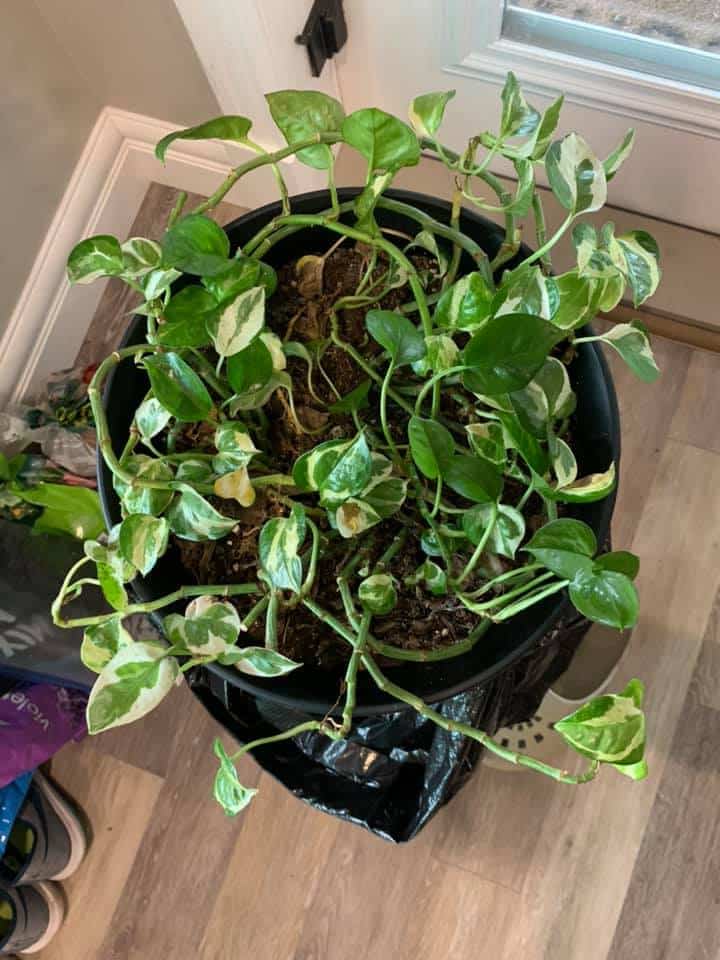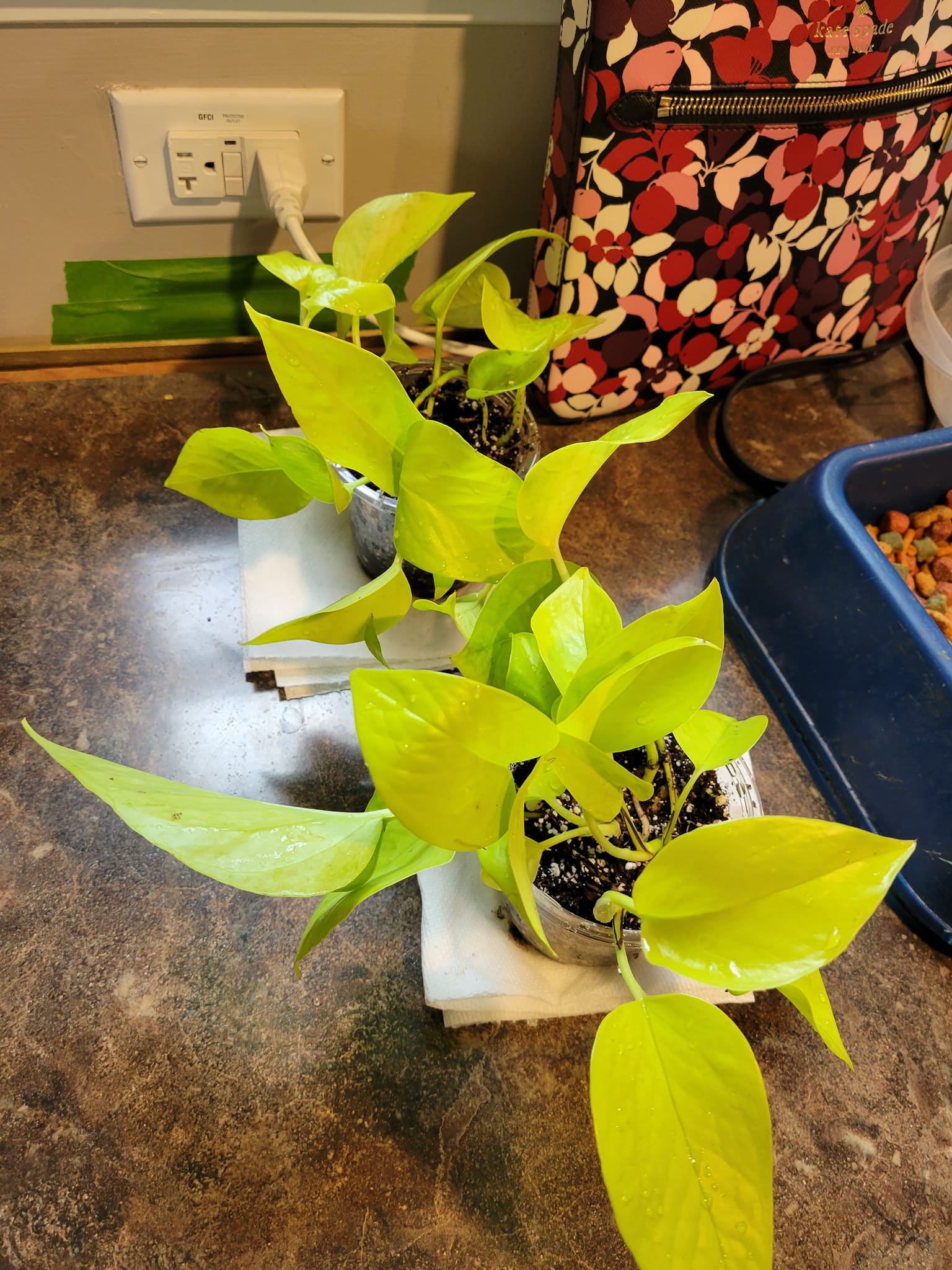If your Pothos start showing signs like yellowing and drooping, remember this fast-growing houseplant hates sitting wet, which may lead to root rot.
However, overwatering alone is not the only cause of Pothos root rot, nor is pruning the infected parts the only solution.
Read on to find out how to identify, diagnose, and treat Pothos root rot before damaging the entire plant.
Table of Contents Show
How to Identify Pothos Root Rot?
Pothos, also known as Hunter’s robe, arum ivy, and money plant, makes a fabulous houseplant thanks to its air-purifying leaves.
However, its aerial root system becomes feeble in wet conditions as too much water will deprive it of the air and nutrients required to expand.

Here is every sign that you may need to identify Pothos root rot.
1. Yellowing and Browning Leaves
Yellowing of the green-pothos leaves may indicate many problems, but one of the probable causes is overwatering and root rot caused by it.
Adjacent lesions on a leaf surface may frequently merge to create larger brown blotches that look circular.
Tiny leaf spots and holes on Pothos leaves may indicate bacterial leaf spots, which requires a different solution.
Expect some yellow to rusty brown leaves accompanying brown lesions and spots.
2. Wilting and Drooping Pothos
Wilting of leaves is one of the early indications of root rot. Please do know that your Pothos has already encountered premature root rot.
It indicates that there are not sufficient feeder roots to keep up with the plant’s water demand.
Therefore, the Pothos begins to reduce water loss by wilting. The dehydrated plant cells collapse and fail to stay erect, causing droopy leaves.

However, leaf scorches are seen during the wilting due to excess transpiration.
Sometimes, wilting is familiar with compact plant pots as the water fails to reach the roots.
Wilting and drooping ultimately lead to the dropping of Pothos leaves.
3. Soft and Brown Roots
The Pothos root will become soft or mushy when the rot proliferates alarmingly.
Mushy stem base caused by overwatering can be reverted, but root rot may require a different solution.
The mushy and slimy root decay indicates that the fungi have started consuming the root.
However, remember this is a severe root rot case that may take a while to show up after the fungus infestation.
Slowed Pothos growth is also a significant sign of root rot, often accompanied by mushy stems, wilting, and yellowing leaves.
4. Fungus or Mold on Soil
White fungus on the soil surface is the byproduct of white mold spores, while a yellow fungal mold is caused by fungal growth.
The fuzzy growth may appear at the base of the plant overnight or within a few days.
The fungus growth will consume water lingering in the pot, leading to even more fungus proliferation and root rot.
Healthy Root Vs. Rotten Root
Slowed Pothos growth is a significant sign of root rot, often accompanied by mushy stems, wilting, and yellowing leaves.
Here are some differences between a healthy and a rotten root system.
| Healthy Root | Rotten Root |
|---|---|
| It looks full with large central root system with sturdy, bushier feeder roots on the sides. | The roots look sicker with feeder roots falling or breaking to touch. |
| It look white or tanned with orange texture. | It looks Brown or dark almost looks black. |
| It feels firm and hard to touch. | It feels soft and mushy to touch. |
| It smells like the soil it is in. | It smells like swamp or slightly sulphurous. |
Pothos Root Rot: Causes & Solutions
Knowing which factor is the probable cause will help you apply the proper treatment before the problem grows.
1. Overwatering the Plant
Frequent watering or providing significant amounts quickly will limit oxygen availability, leading to a choking root system.
Waterlogging the soil will deprive the air circulation around the roots.
It eventually leads to a fungal buildup in the soil, damaging the root system.
Yellowing and browning of the leaves indicate overwatering, which requires immediate diagnosis and treatment.
Remember, the aerial roots of the Pothos will only increase when the soil remains well-aerated and porous.
Practical Solutions
- Water every week in spring and summer and nothing more than 500 ml in fall and winter every two weeks.
- If the problem persists, slide the plant out to check for decayed roots.
- Trim browned leaf if the discoloration has taken over the entire leaf to prevent further growth.
2. Poor Soil Drainage Capacity
The compact soil lacks air pockets, which allow water to drain quickly through the soil.
With poor drainage, the water will begin storing inside, drowning the leaves and leading to fungal growth.
Compact soil and overwatering can become the worst concoction of disaster.
Your Pothos root will be sitting on stale water around the clock, which may increase the fungal growth.
The Pothos grown in pots are more likely to suffer from poor drainage as the soil dwindles in healthy microbes from continuous fertilization and water saturation.
Practical Solutions
- Check whether the soil feels light-colored and hard to touch. It would crumble as you put pressure on it.
- The only solution is to repot the plant in a new and correct substrate.
- Prepare a soil mix containing porous materials like peat moss, coco coir, shredded bark, and perlite to allow water drainage.
3. Extra-large or Small Pots
An extra-large pot would require frequent watering to moisten the soil, while small pots will bind the root growth causing clogged soil.

Both scenarios are bad for Pothos roots, inviting unnecessary water retention and eventually fungal growth.
Remember, Pothos require only slightly moist soil; excess water retention would mean the roots are drowning.
Practical Solutions
- Slide out the plant, prune any decayed root, and move it to an appropriate-sized pot.
- Always choose a pot with a diameter of at least one inch wider than the diameter of the plant’s root mass.
- Pothos with fast-growing roots and stems require a pot up to four inches wider than the root mass.
- Change the pot every year in early spring to accommodate rapid root growth.
4. Overfertilized Plant
With excess and frequent fertilization, the salt will reach a toxic level, stressing the root system and making it more susceptible to fungal and bacterial attacks.
Do not worry; most overfertilized Pothos can be saved in a few steps.
Practical Solutions
- Run the pot under tap water to leach away excess fertilizer, and repeat the process several times.
- Prune off damaged leaves and stems from diverting the energy towards healthy growth.
- If the plant does not revive, slide it out and prune off the severely decayed root system.
- Repot the plant in a fresh mix and avoid fertilizing for at least three months.
5. Temperature Fluctuation and Drought Stress
High temperature and low moisture elicit the most heightened disease susceptibility.
With a drying root system and transpiring leaves, the root will attract the phytopathogenic fungus Rhizoctonia bataticola.
It will lead to damping off, stem lesions, stem and root rot, and blight.
Although more common with industrial crops, it may affect houseplants under duress from the wrong temperature and moisture level.
Ensure the temperature stays between 70°F (21°C) and 90°F (32°C) range.
Practical Solutions
- Prune off infected parts and transplant them into a fresh soil mix.
- Otherwise, treat Rhizoctonia by treating Terrazole, a fungicide with 40% pentachloronitrobenzene (PCNB).
- If the temperature drops below 60°F, then use an artificial heating system.
- Mist the plant’s leaves and increase the watering frequency from once to twice a week.
6. Excess Humidity
When Pothos roots are exposed to overly moist conditions for too long, they become susceptible to fungal growth, such as fungus gnats whose larva feed on the roots.
Similarly, wet leaves and stems will promote mold and bacterial growth that may cause leaf dropping and attract pests to lay eggs.
It further increases the root and crown rot, leading to a sick-looking plant.
Practical Solutions
- Move the plant to a warm location with ample indirect sunlight.
- To maintain humidity, mist your plant in the morning, but do not go overboard.
- Measure the humidity level around your plant with a hygrometer.
- Add a room humidifier to maintain the ideal relative humidity level around the plant.
7. Pathogenic Infections
All the above causes may lead to pathogen infection in Pothos, where Pythium, Phytophthora, and Rhizoctonia are the most common.
a. Pythium Root Rot
Pythium root rot is caused by Pythium irregulare, Pythium ultimum, and Pythium aphanidermatum.
These pathogens are present in Pothos with excessively wet roots, poorly draining substrate, and soil rich in organic matter.
Using contaminated potting soil mix may also invite Pythium root rot.
b. Phytophthora Root Rot
Phytophthora sojae is a water mold that will cause root rot in Pothos. It is prevalent in either high soil moisture or saturated soil conditions.
Other times, it is spread by air-borne spores from disease-infested plants.
c. Rhizoctonia Root Rot
Rhizoctonia spp is another pathogen that will spread through the air and enter the soil.
Other times, overhead watering and high temperature may invite pathogen spores.
You would witness yellowing and wilting leaves with stems dying back in these infections.
Practical Solutions
- Apply fungicide containing copper or Benomyl to the cut areas and repot in a fresh potting mix.
- Otherwise, pour a diluted Chlorothalonil or Agrimycin fungicide into the soil directly.
- Alternatively, mix herbicides like Neem oil or hydrogen peroxide in water and pour it over the plant and soil.
Here is a video highlighting how to save the Golden Pothos species from root rot.
Natural Fungicides to Treat Root Rot in Pothos
Natural fungicides improve soil quality and are inexpensive, accessible, and eco-friendly.
Here are a few natural fungicides you might want to try.
| Fungicides | Usage |
|---|---|
| Amazon | Mix 1 teaspoon of raw neem oil in 1 liter of water. Add 3-5 drops of dish soap, make a mixture and apply. |
| Cinnamon | Sprinkle cinnamon powder on soil. Make a spray using powder cinnamon, make a strong tea and spray on the underside of leaves. |
| Baking Soda | Take a gallon of tepid water, mix 3-4 tablespoons of baking soda and 1-2 tablespoons of vegetable oil. Spray the mixture on the soil. |
| Chamomile | Take quarter or half cup of chamomile flower and add 2 cups of boiling water. Let the mixture cool down and spray it. |
| Apple Cider Vinegar | Mix 3 tablespoons of apple cider vinegar into a gallon of water and spray it to the soil and the plant. |
From Editorial Team
Conclusion!
Pothos is one of the most popular houseplants, where you could find at least one out of every five homes growing them.
Pruning the infected roots and applying some fungicide before repotting them is the best practice to inhibit root rot in Pothos.
However, immediately cut back on watering and move the plant to a warm location as soon as possible.


